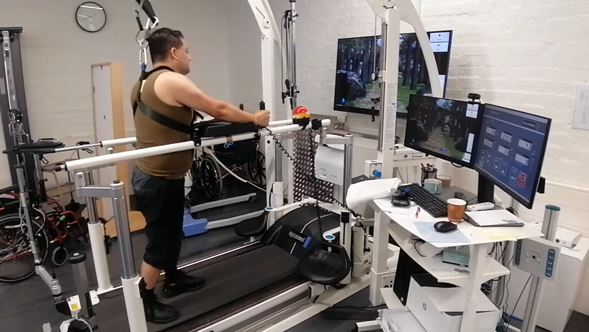Lifetime Support Authority funded research helps Bee get back on her feet.
Bee sustained a spinal cord injury in a motor vehicle accident in May 2021. The serious nature of her injury meant she met the eligibility criteria for the Lifetime Support Scheme (LSS) and the Lifetime Support Authority (LSA) accepted her as a LSS Participant.
Before the accident, Bee was an active person who enjoyed travelling and lived a vibrant, and social life. But the effects of her motor vehicle injury, including being unable to feel any sensation in her legs and feet, negatively impacted her confidence and made it difficult for her to weight bear.

Bee’s recovery goal was to spend as much time as possible standing and weight bearing out of her wheelchair. She faced significant barriers to achieving this goal because she could only perform these tasks with the support of allied health professionals. She was too scared of falling to leave her wheelchair outside of physio sessions.
In her early recovery days, Bee was rarely weight-bearing for more than five minutes at a time and was unable to walk more than 10 metres with a rollator frame.
However, in 2022 this all changed. Bee participated in an innovative LSA funded research study to investigate if new technology could improve physical health after a complex trauma injury.
The LSA funds research, education and programs that ultimately aim to make a positive difference for participants and the Scheme. Positive outcomes are achieved when an individual can successfully transition from an acute injury phase to living their life independently.
The study, conducted by the University of South Australia and led by Dr Brenton Hordacre, involved Bee walking on a special treadmill with innovative features that included support to stand, robotic assistance to move the legs in a normal walking pattern as well as sensors and visual screens to make rehabilitation more enjoyable.
The unique features of the treadmill helped Bee improve her physical abilities.
“The ramp enabled me to easily get on and off the treadmill and the body support harness gave me the confidence to push myself, knowing that I was in a safe environment and would be unable to fall and hurt myself,” explains Bee.
“The sensors and audio feedback allowed me to know when my feet had touched the belt after taking each step – something that I am usually unaware of without looking down, due to having no sensation in my legs or feet.”
During the research study Bee completed two treadmill rehabilitation sessions per week over a five-week period. She saw measurable physical improvements throughout the study and by her final session she achieved her goal of walking one kilometre in 57 minutes.
“I didn’t think this was possible, but I was able to because of the safety equipment and visual aids,” said Bee.
Participating in this research study helped Bee to gain confidence in her physical abilities and transfer those movements to her work and home life. For the first time since her accident, Bee felt safe enough to attempt standing and weight bearing without the help and supervision of health professionals. She now has greater independence and access to items beyond her reach in her wheelchair.
“Although I am still a full-time wheelchair user, I can now carry out small functional tasks at home such as opening my windows and standing to reach things out of a cupboard.”
Seeing physical progress also helped Bee’s mental health. She is now more motivated to continue her physical rehabilitation and more positive about movement in her day-to-day life.
Preliminary findings from this research are showing positive results for other study participants as well. To learn more about research projects funded by the LSA, visit the Grants page.
*LSS Participant Bee has asked not to be identified in this story. Bee is not pictured. The image shows another research study participant using the special treadmill.

